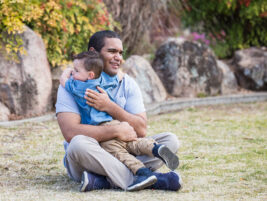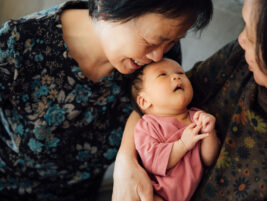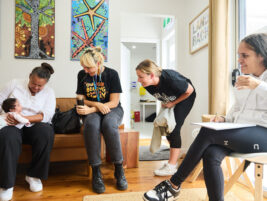Introduction
Provision of adequate nutrition to enable growth and development is one of the most important aspects of caring for a baby. The responsibility for feeding the baby usually falls on the parents, particularly on the mother. The feeding relationship between baby and parent is important and forms a crucial basis for the emotional development of the baby and contributes greatly to the parent’ s ability to experience the care of their baby with confidence and satisfaction. (Satter, 1999). Rosenblum, 2004, describes feeding as a “relationally embedded phenomenon” (p61). When oral feeding of the baby is compromised, or even impossible, the parent-infant interaction is made more complex and is at risk of disruption (Drotar & Robinson, 2000., Benoit 2000).
Many infants beginning life in a neonatal intensive care unit (NICU) or in a Special Care Nursery (SCN) receive some or all of their nutritional needs through a feeding tube, either an oro-gastric tube, a nasogastric tube (NGT) or a gastrostomy tube). It is difficult to separate the need for tube feeding from the complex medical and/or surgical problems that necessitate the placement of the tube (Minde, 2000). The parent’ s perception of the tube may often be difficult to disentangle from their experience of having a baby with a life threatening illness.
Increasingly infants are discharged from hospital while remaining dependent on the use of a feeding tube to maintain growth. Parents must learn to manage all aspects of tube feeding to enable their baby to be discharged to their care at home. As well as learning the complex process of administering a tube feed many parents also undertake the responsibility for inserting the NGT through their baby’ s nasal passage and pharynx to the oesophagus, whenever it needs replacing.
Summary of relevant literature
A growing body of literature related to parental perceptions of tube feeding, usually gastrostomy tube feeding, in older infants and children is emerging. Literature related to psychosocial aspects of pediatric medical complexity and chronic ill health provides further insights to the experiences of parents and their children.
Family dynamics, coping mechanisms and reference to “psychological scars” have been described as relevant to discharge planning for young children with gastrostomy tubes (Huddleston and Ferraro, 1991).
Physiological gains, supplemented by some data supporting psychosocial impact of tube feeding are documented in the quantitative literature (Tawfic, Dickson, Clarke & Thomas (1997), Smith, Camfield & Carol(1999), found that, along with medical and mechanical complications of the tube placement, 28% of families reported problems with family functioning and stress. Data from this study were analyzed using quantitative methodology. Specific psychosocial problems revealed by Smith et al were restricted mobility, difficulty with respite care, impact on relationship with the child and the child missing the taste of food.
Tube fed children have been found to experience a high level of stress, related to the severity of their child’ s medical condition and the constant care giving demands over extended periods. Parents of tube fed children were found to have higher levels of stress than either of two control groups. (Pederson, Parsons & Dewey, 2003).
Craig, Scambler and Spitz (2003) used semi-structured interviews and constant comparative methodology, to arrive at the following themes: experiences of feeding, referral, significance of oral feeding, the child’s enjoyment of feeding, maintaining skills, perceived benefits and the need for evidence, complications of the procedure, the anti-reflux procedure andemotional and support needs. The authors recommended that families and clinicians might benefit from discussion of hopes, expectations and limitations of the procedure prior to surgery, with review of the same factors following surgery.
Two related articles in the nursing literature, outline the experience of long-term gastrostomy in children with disability, and with insights from nursing staff (Thorne, Radford & McCormick, 1997; Radford, Thorne & Bassingthwaighte, 1997). These papers, based on qualitative research, examined perceptions of a group of nurses and a smaller group of parents. Among the categories deliniated were: giving up hope, ending the struggle, caregiver convenience, relinquishing normal and maternal failure.
Family adjustment to chronic physical disorder was influenced byintra-personal factors, social-ecological factors and stress processing (Wallander and Varni, 1998). In a review of literature on family coping with chronically ill children Meleski (2002) discussed shifting responsibilities and disequilibrium during transition times, along with chronic sorrow.
Mismatch of perceptions between home care nurses and parents, regarding caring for technology dependent children was raised by O’ Brien and Wegner (2002). The authors recommended improved communication and collaboration between parents and home care nurses.
A study of parental stress in the neonatal intensive care unit provides some insight into the age group of interest to the current study. Dudeck-Shriver (2004) used a parental stress measure to study factors predictive of parental stress. High levels of stress were found related to baby-parental role and the appearance of the infant.
Franklin and Rodger (2003) studied parental perspectives and psychosocial implications of feeding the children using in-depth interviews and a mealtime observation. The following themes emerged: fear for the child’s survival, stress on the parent-child relationship, increased parenting responsibility and adjustment, and coping with chronic stress. This shift to consideration of the parent-child relationship may indicate the emergence of some focus on the baby as well as the parent.
Method
Parents of six babies from the researchers clinical caseload were interviewed, using semi-structured interviews. Minichello’s (1992) description of in-depth interviews formed the conceptual basis for the interviews. Interviews were conducted either in the hospital setting and in the interviewees’ own home as chosen by the interviewee. Interviews were videotaped and the data transcribed to personal computer for analysis.
Analysis of data used the constant comparitive process (Glaser & Strauss, 1967). An open coding system (Miles & Huberman, 1994) was used to code each conversational turn, or embedded unit of meaning, in the interviews. Codes were progressively refined as themes emerged. Relationships between codes were identified and themes labelled according to collections of topics and meanings (Frick, 2002). Analysis ceased when all units of relevant conversational turns were assigned to a theme.
Ethical approval for the study was obtained through the interviewer’s hospital ethics committee.
Participants
Families of six infants, between the age of four and ten months were selected for interview. Three couples, comprising mother and father, and three mothers alone were interviewed. Diagnoses for the infants comprised a range of complex medical conditions, all of which had meant a lengthy stay in a neonatal unit at a major paediatric hospital. Length of hospital stay ranged from 18 days to 294 days.
Results
Emerging Themes
A visual reminder of illness
When parents first see the feeding tube it reinforces to them that their baby is severely ill.
- A constant reminder that things aren’t exactly right with her…
- It concerned me more than anything, because that meant it was something serious…you see tubes and you think that
- The thing up her nose was the least of our worries.
The tube as a necessity
Parents generally acknowledge that the feeding tube is essential to keep their baby well nourished.
- But is does mean that she gets everything nutritionally
- But then again there may be positives to it. Because then you know what she getting nutritionally. That she is getting everything she needs.
The hospital context
The hospital is a difficult environment but one for which parents develop coping strategies.
- With my sister, both her and I were reprimanded for looking at the other babies and thought “Goodness, what have we gotten into here?”. When we found out what the rules are we thought ”Oh well. We’ll fit in here”.
- You quite like coming in here and seeing other children with tubes.. You think Yeah! They’re quite normal in here.
Interaction with hospital staff
Parents were thankful for the work done in keeping their child alive but expressed a range of negative perceptions. They felt powerless, unlistened to, and, with their baby, at the mercy of the system.
- People are generally here to make her healthier and happy.
- I don’t think a lot of people are really that experienced at putting the tube in..
- Its because they have to do it. It’s not just doing it for the sake of.. ”Oh we’ll practice this on Jennifer”.
- They don’t want to take any advice from you or talk about it and realise that you know your own baby.
- If you’re not happy, learn to say no, learn to ask the nurses how they are doing it. Don’t assume or trust.
The trauma of inserting the tube
Parents feel traumatised and recognise the trauma to their baby. They may “switch off” to the trauma.
- I burst into tears I couldn’t believe I had just done that to my son. It was my way of helping him, to bring him home
- Oh its horrible.. You want to tear them apart. When Frank does it at home… the two of us nearly kill each other through the whole time its being done.
- If you are gently you can actually feel it go down.. and you can feel when its stopping. If she’s upset or crying you just stop it there and then she’ll calm down a bit, she’ll breathe in.. and it will go through.. It just sucks itself through.
- I know it has to go in. You sort of switch off to her cries. Usually the people who try to help me get all distraught.
Social reactions to the tube
Parents feel criticised, but also acknowledge that strangers feel concerned about their child. The tube is the focus for comment rather than the baby.
- And people think we’re like, you know, bad parents or something.. Friends who have got kids think we must have done something wrong that we can’t feed out baby…
- I had a guy in the bank one day come up to her and say “What’s that up its nose for?”, at the top of his voice… And we’ve also had people who were just gorgeous. It brings out the good side in people.
- I went out to the shops once when it was out and I really did notice a difference… A lot of people came up and said “Oh look at the red hair” rather than just looking at the tube..
- Some people think it’s a bit strange. It’s being cruel you know. How can you shove something up her nose and feed her that way.
Effect on social interaction
Complex medical conditions limit social interaction and lead to feelings of isolation. However, parents express the need to find ways to manage.
- You can still go out sometimes and feed them out. I’ve done it before. It can be horrible sometimes because you do get looks.
- I’ve been to play group committee meetings and just hung up the tube and carried on.
- I’ve done them in all sorts of places. I’ve hung it on the tree.. when my cousin was getting married.
- We’ve slowly started to visit our friends. At first the tube isolated him.
Need for information
Parents appreciate the teaching they received in hospital but felt a lack of written information to refer to when away from the hospital.
- I think there needs to be a bit more… not necessarily maybe a support pack but I think definitely more information about the tube and what it’s doing and how it’s done, to the parents.
- (So you learned from watching other people do it?) Yeah, and basically, when you get the um, the tube, it has instructions.
The baby’s reaction to the tube
Parents perceive the baby as having a love-hate relationship with the tube. They attribute the baby with acceptance but also the wish to be rid of it.
- I think he knows it’s the only way.
- He starts to gag or go blue. Maybe he’s retaliating.
- She’s a very forgiving little person. Often after she been screaming, having the tube done. She looks up as though to say “Well. Thank You”.. she seems to know that it’s necessary, that its not a deliberate ploy on my part to torture her.
- She loves the tube. She plays with it.
The tube as “part of the baby”
Parents perceive that the baby might think that the tube was a part of its body but acknowledge that the baby was aware of its intrusiveness.
- It’s part of her. If she hasn’t got it in I think she looks so strange
- You know it’s just like playing with your foot.
- She was little at that stage, to see something like that go into her body was horrible you know.
- Often when she gets distressed she will try to rip it out… but other than that it’s quite normal for her.
Responsibility
The parent who takes on most of the responsibility might express disappointment and anger towards their partner and other family members. They also feel unable to rely on the usual community support networks.
- I panic if my partner is not here. I need someone else
- Try to teach someone else how to change the tube. I never did.
- I’ve got a good friend who’s a nurse and she said she wouldn’t baby sit her
- You can’t just rock up to a normal childcare centre and say “Here’s my child”… They all go “OoooH”.
Summary of Findings
The tube has multiple meanings, often contradictory:
- It keeps the baby healthy, but it is unnatural and inconvenient;
- It is part of the baby but it is an intrusion into his body
- It signifies severe illness but doesn’t need to restrict normal life.
The baby, and the effect of the tube on the baby, underpins many of the parents’ perceptions regarding the feeding tube.
Parents express ambivalence towards the tube and tube feeding, and about the care provided for their baby.
Parents report anxiety about the potential for events that may threaten their baby’ s life and the need to be constantly vigilant.
Responsibility for tube changes falls on one parent, who often feels unsupported.
The presence of the tube need not limit social interaction but uninformed public causing parental frustration and anger.
Hospital staff are generally skilled and helpful but not always consistent. Some staff are inexperienced and cause frustration to parents and distress to the baby.
Discussion
The aim of this study was to use a qualitative research paradigm to describe the parental experience of caring for a child who received some or all of their nutrition via a feeding tube. Most of the findings relate directly to perceptions regarding the use of a nasogastric tube (NGT). Only one child had undergone surgical insertion of a gastrostomy tube, and the insertion of the gastrostomy tube followed six months of NGT use. While some of the issues discussed might span the use of both types of tube feeding, most of the findings relate to use of the NGT.
As most of the relevant literature related to pediatric tube feeding deals with gastrostomy feeds in a population of children older that one year, this study, as would be expected revealed themes not pertinent to the populations outlined in the literature. For example, the fact that five out of the six families in the current study had one parent who was responsible for inserting the NGT led to the emergence of data specifically related to that event, which was generally a source of trauma to the responsible parent and to the baby. Whether this trauma was greater than that experienced when the child has a gastrostomy tube in place was not the subject of this study. The experience was different, not necessarily greater, although the strength of some parent’ s emotional expression might lead to the conclusion that the trauma was also greater.
As expected, separating perceptions of tube feeding from perceptions related to the baby’ s complex medical condition and the need for extended hospital stays, was not always possible. All of the infants began life with an admission to the neonatal unit at a major teaching hospital, some in a neonatal intensive care unit (NICU) and some in a Special Care Nursery (SCN). Experiences with hospital staff, and the hospital environment, were clearly remembered and described by many parents. Even when a parent stated that they had difficulty remembering the first few days or weeks, when an NGT was inserted, they went on to give accounts that suggested firmly implanted memories, held close to the surface and probably influencing day to day perception of the infant and the feeding process.
The experience for the baby was more difficult to outline clearly. It was the baby as represented in the parent’ s mind whose experience was described in some detail. The real baby was observed during the taping of interviews and some notes made but comprehension of the babies’ behaviors during the taping sessions was difficult. At times it seemed that the baby was clearly intending to ‘ have a say’ , but the young age of the baby and the fact that the interviewer was intent on understanding the parents’ expressions, prevented the baby making his or her meanings clear. As infant communication is generally clearer when expressed as part of an interaction with a parent or other significant person, a different type of infant observation might be the topic of further study with the aim of elucidating the infant experience of mealtime when the food arrives via a tube.
Before the commencement of the study it was anticipated that prior parental experience with both complex medical conditions and with feeding difficulties would influence the experience with their own baby. Only two clear instances of prior parental experience arose as topics during the interviews. The interviewer did not specifically ask about prior experience and this may have influenced the lack of comments related to their own experience. Because of the strength of emotion behind the two descriptions of prior experience they were regarded as significant in the development of themes.
At times, the perceptions outlined by the parents’ were contradictory, perhaps reflecting a degree of ambivalence. Parents, on the one, hand were thankful towards the hospital and hospital staff for enabling their child to survive and thrive. At other times during the interviews the same parent might be critical of the hospital and staff and give clear expression of anger and frustration caused by staff behaviors and/or the hospital environment.
Ambivalence towards the tube was also expressed. The tube was hated and the source of trauma to parent and baby but was also loved by the baby and a useful means of nourishing the baby for the parent. Times without the NGT were described as a source of pleasure for the parent, a break from society’ s assumptions regarding the tube and enabling glimpses of the child that was more usually hidden behind the tube. The same parents had also to assure the interviewer that they loved their baby even with the tube in place.
Only one parent spoke explicitly about difficulties with attachment to their baby (Zeanah & Boris, 2000). This mother referred to attachment by talking about the need to ‘make friends with’ her baby because of the number of people closely involved with him in the SCN setting. The topic of parent-child interaction in the NICU and SCN environment is written about by Minde (2000) and is a frequent focus of clinical assessment and intervention with infants with complex medical conditions, within the field of infant mental health. Further exploration of attachment in this population of medically complex infants needing tube feeds in the early infancy would be a welcome addition to the literature.
The current study was exploratory in nature and adds new information to the very sparse body of literature related to the needs of parents and infants when the infant has a feeding tube. It revealed themes that were specific to medically complex infants, not raised in other studies involving older children from different diagnostic categories. There were also themes which were applicable across wider populations of children, similar to some of the themes outlined in the literature cited earlier in this article (Craig et al, 2003; Smith et al, 1999; Thorne et al, 1997).
Results of the current study would be useful as a basis for further exploration of the experience of tube feeding for parents and infants. The themes could, for example, inform the development of a comprehensive questionnaire with the aim of confirming and/or extending the data presented in the current study.
A study that focused of the experience for the baby would provide information, important to the management of tube feeding and the prevention of feeding problems.
References
Benoit, D. (2000). Feeding disorders, failure to thrive, and obesity. In C.H. Zeanah (Ed.) Handbook of Infant Mental Health, (pp. 339-352) New York: Guilford.
Chatoor, I., Dickson, L., Schaefer, S. & Egan, J. (1985). A developmental classification of feeding disorders associated with failure to thrive. In D. Drotar (Ed.), New Directions in Failure to Thrive: Implications for Research and Practice. (pp. 235-238). New York: Plenum.
Craig, G.M., Scambler, G. & Spitz, L. (2003). Why parents of children with neurodevelopmental disabilities requiring gastrostomy feeding need more support. Developmental Medicine & Child Neurology. 45, 183-188.
Drotar, D. & Robinson, J. (2000). Developmental psychopathology of failure to thrive. In A.J. Samaroff, M. Lewis, & S.M. Miller (Eds.) Handbook of Developmental psychopathology (2nd edition)(pp. 351-364) New York: Plenium Press.
Dudeck-Shriber, L. (2004). Parent stress in the neonatal intensive care and the influence of parent and infant characteristics. American Journal of Occupational Therapy. 58(5), 509-20.
Flick, U. (2002). An introduction to qualitative research. (2nd edition) London: Sage.
Franklin, L. & Rodger, S. (2003). Parents’ perspectives on feeding medically compromised children: Implications for occupational therapy. Australian Occupational Therapy Journal. 50, 137-147.
Glaser, B.G. & Strauss, L.A. (1967). The discovery of grounded theory: Strategies for qualitative research. New York: Aldine de Gruyer.
Meleski, D. (2002). Families with chronically ill children: A literature review examines approaches to helping them cope. American Journal of Nursing 102(5), 47-54.
Miles, M.B., & Huberman, A.M. (1994). Qualitative data analysis: An expanded sourcebook (2nd edition) London: Sage.
Minde, K. (2000). Prematurity and serious medical conditions in infancy. In C.H. Zeanah (Ed.) Handbook of Infant Mental Health (pp. 176-194) New York: Guilford.
Minichiello, V., Aroni, R., Timewell, E., & Alexander, L. (1990). In-depth interviewing: Researching people. Melbourne, Australia: Longman Cheshire.
Morse, J.M. (1998). Designing funded qualitative research, in N. Denzin and Y.S. Lincoln (Eds.) Strategies of Qualitative Research. London: Sage. p 73.
O’Brien, M., & Wegner, C.B. (2002). Rearing a child who is technology dependent: Perceptions of parents and home care nurses. Journal of the Society of Pediatric Nurses. 7(1), 7-15.
Patten, M. (2002). Understanding research methods: an overview of the essentials (2nd edition) Los Angeles: Pyrczak.
Pederson, S.D., Parsons, H.G. & Dewers, D. (2004). Stress levels experienced by the parents of enterally fed children. Child: Care, Health & Development. 30(5), 507-513.
Rosenblum, K. (2004) Defining infant mental health. In A.J. Samaroff, S.L. McDonough, & K.L. Rosenblum (Eds.) Treating parent-infant relationship problems- strategies for intervention (pp. 43-75) New York: Guilford Press.
Radford, J., Thorne, S., & Bassingthwaighte, C. Long-term gastrostomy in children: Insights from expert nurses. Issues in Comprehensive Pediatric Nursing. 20(1), 35-50.
Rouse, L., Herrington, P., Assey, J., Baker, R. & Golden, S. (2002). Feeding problems, gastrostomy and families: A qualitative pilot study. British Journal of Learning Disabilities. 30(3), 122-128.
Satter, E. (1999). The feeding relationship. In D.B. Kessler & P. Dawson (Eds.) Failure To Thrive And Pediatric Nutrition: A Transdisciplinary Approach. (pp. 121-145) Baltimore: Brookes.
Smith, S.W., Camfield, C. & Camfield, P. (1999). Living with cerebral palsy and tube feeding: A population-based follow-up study. The Journal of Pediatrics. 135(3), 307-310.
Strauss, L.A. & Corbin, J. (1990). Basics of qualitative research. London: Sage.
Tawfik, R., Dickson, A., Clarke, M. & Thomas, A.G. (1997). Caregivers’ perceptions following gastrostomy in severely disabled children with feeding problems. Developmental Medicine and Child Neurology. 39(11), 746-751.
Thorne, S., Radford, J. & McCormick, J. (1997). The multiple meanings of long term gastrostomy in children with sever disability. Journal of Pediatric Nursing. 12(2), 89-99.
Wallander, J.L. & Varni, J.W. (1998). Effects of pediatric physical disorders on child and family adjustment. Journal of Child Psychology and Psychiatry. 39(1), 29-46.
An Exploration of the Experience of Parents Caring for Babies Fed by Naso-gastric Tube
Authors
Ferguson, Libby,
Senior Clinician, Speech Pathology Department, Royal Children’ s Hospital. Melbourne.
Campbell, Paul,
Assoc. Professor, Infant Psychiatrist, Mental Health Service, Royal Children’ s Hospital. Hon. Principal Fellow, The University of Melbourne.








